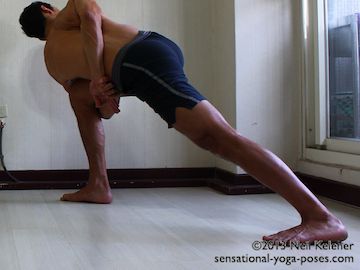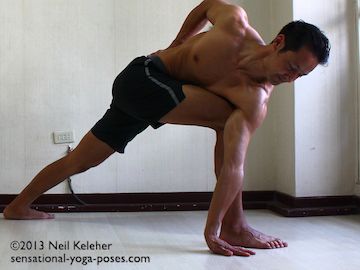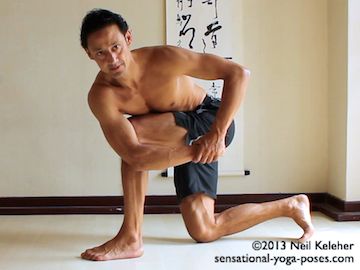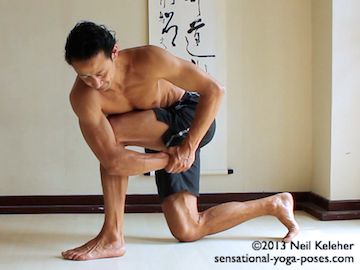Bound Twisting Side Angle Pose
An advanced binding and twisting yoga pose
In bound side angle pose, you turn your body away from the leg you are binding. You could call this an open bind since your are wrapping to the inside of the inner thigh.
You can do an external bind in twisting side angle pose (parivrtta parsvokonasana). In this case you twist towards the leg you are (trying) to bind and wrap from the outside of the thigh.
Preparing to Bind in Twisting Side Angle
A preparation to binding in bound twisting side angle (and a possible prerequisite) is getting the hand to the floor with the arm crossing the outside of the thigh in twisting side angle pose.
Note that body proportions can make a difference in this pose! If you have short thighs relative to your torso you may find it difficult to get your hand to the floor with your arm to the outside of your thigh. You'll have to reach your hand further back. You may also find that binding is difficult (as if it isn't hard enough already in this pose.) One possible way around this is to work at depressing the shoulder of the bottom most arm so that your shoulder moves closer to the knee of your front thigh.
Internally Rotating Your Arm to Bind
Once you can get that hand to the floor (and you can use this as a pose in and of itself) the next step is to bend the elbow so that your forearm is horizontal. So that your forearm reaches beneath the thigh you'll have to internally rotate it. And for this you can use your other hand to help. Use it to push the forearm under the thigh.
Note that to do this successfully your elbow will have to be at or below the level of the bottom of the thigh. If you touched your hand to the floor in the previous pose this shouldn't be a problem.
Modifying the foot position
I should have wrote this first, but you can modify the leg position prior to trying to bind Instead of doing the pose with the back leg straight, bend the back knee and put it on the floor. Then try to touch your hand to the floor with your arm crossing the thigh. Then after that, try binding.
From Modified to Full Version of Bound Twisting Side Angle
If you started with the modified foot position and then bound, you could try entering the full position while keeping the bind. Slowly straighten the back knee and then turn the foot out and place the sole of the back foot on the floor.
In the full pose you may have trouble balancing. Try to stabilize your front leg by pressing the inner thigh down. Press down through the root of the big toe at the same time.
To deepen the twist as you bind, keep your outer thigh strong and press your arm against the outer thigh. Use your bottom shoulder to help pull the bottom side of your ribcage past the thigh. Pull the top shoulder and the top side of the ribcage back.
You may also find it interesting to try and bend the thoracic and lumbar spine back slightly using the spinal erectors.
Warning!
It may be better to end with a warning rather than begin with one. It might stick a little bit better. This pose counts as an advanced pose. You are potentially placing a lot of stress on your elbow(s), shoulder(s), spine and even potentially the hips.
The body is pretty resilient, so if you are young and enthusiastic you may get away with doing this pose without paying too much attention. It's part of the joys of doing yoga.
However, as you grow in your practice, you mind find it beneficial to work towards this pose more gradually. Take the time to explore the intermediate poses, and if you experience joint pain, then don't do it. Or modify the way you do it.
Generally joint pain is a sign that something is wrong. And that means adding muscle tension not to force yourself into the pose, but to give your joints the support that they need. The idea here is that muscle tension does affect the joints directly.
Published: 2017 11 15
Updated: 2021 02 09






